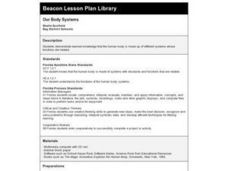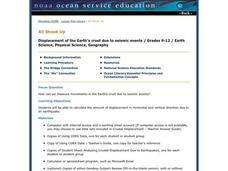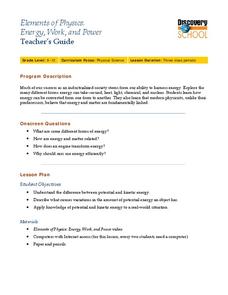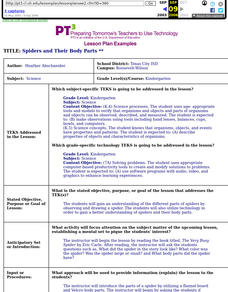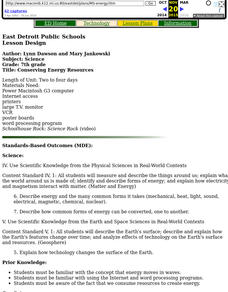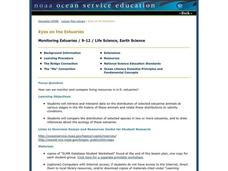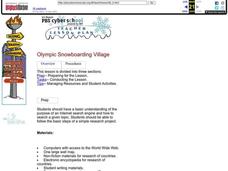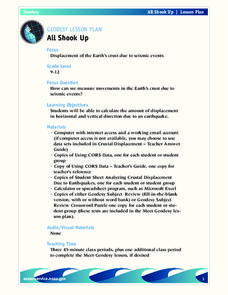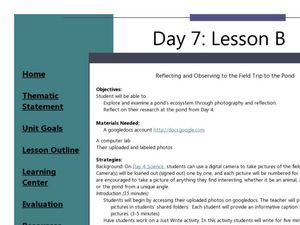Curated OER
Forces and Motion
Fifth graders participate in a series of hands-on, Web-based activities and video-based activities to extend their learning of Forces and Motion.
Curated OER
Our Body Systems
Second graders demonstrate how the human body is made up of different systems whose functions are related. They trace their bodies on butcher block paper and put in at least five of the body systems in the appropriate area of the body.
Curated OER
All Shook Up
Students calculate the amount of displacement after an earthquake. In this seismic event lesson students research the Internet, and fill out a CORS data sheet.
Curated OER
Backyard Bacteria
Students experiment with different bacterias that they found and make predictions of their growth. In this investigative activity students use petri dishes to grow their bacteria then summarize what has happened.
Curated OER
Puzzling Planets
Learners examine the concept of a solar system. In this research based lesson, students compare a star and a planet. They explain the requirements for life in a biosphere.
Curated OER
Energy, Work and Power
Students examine the differences between potential and kinetic energy. In this physics instructional activity students view a video and apply what they learn about energy to apply it to real world situations.
Curated OER
Motion, Force, and Gravity
Learners write a research paper about human space travel. In this space travel lesson, students watch a video and research issues related to space travel. They use their research to write a paper about whether human space travel should...
Curated OER
Lift Relationships
Students use FoilSim (downloadable) to determine how lift is affected by varying parameters on the Airfoil simulation.
Curated OER
Lesson Plan
Pupils play several activities that allow them to know the terminology used. In this project management lesson students create a storyboard.
Curated OER
A Multimedia Presentation to Describe Newton's Laws of Motion
Eighth graders use various sources to find pictorial evidence of Newton's laws of motion in everyday life. They use various sources of technology to import those pictures into a multimedia presentations.
Curated OER
Making Blood!
Ninth graders study facts about human blood and what it is made of. In this blood composition lesson plan students divide into groups and complete several activities.
Curated OER
Upside-Down Wings
Students use FoilSim to demonstrate that the graphic analysis of the airflow around one object can be used to hypothesize airflow graphs for objects as they are elongated from a sphere to an airfoil shape.
Curated OER
Design of Airfoil for Given Lift
Students use FoilSim to design an airplane wing that generates a given lift. As they change parameters such as airspeed, altitude, angle of attack, thickness and curvature of the airfoil, and size of the wing area, the software...
Curated OER
Actual Airflow vs. Ideal Airflow: Stalls
Students use 3-D modeling techniques to observe the characteristic signature of the stall condition apparent on an airfoil at high angles of attack. They use FoilSim to compare the above with ideal airflow.
Curated OER
Spiders and Their Body Parts
Students gain an understanding of the different parts of spiders by observing and drawing a spider. They utilize technology in order to gain a better understanding of spiders and their body parts.
Curated OER
Conserving Energy Resources
Seventh graders research on energy conversion. After they have researched several types of energy resources, teams of two to four create posters which depict how these resources can be conserved.
Curated OER
Star Child Astronomy
Students gain understanding of the relationship of Earth within the Solar System. They increase knowlegde of the planets, sun, moon, meteoroids, asteroids and comets.
Curated OER
Tread Lightly: Visualizing Footprints
The student reflects on concepts of ecological footprints and climate changes. In this Art lesson, students will produce a visual representation showing understanding of how ecology and climate affects the world.
Curated OER
Eyes on the Estuaries
Students study estuaries and compare several ones in the U.S. In this estuary activity students interpret data and compare the distribution of different species.
Curated OER
Olympic Snowboarding Village
Students adopt a country to research and tour the country online. They plan a trip from Nagano back home to their country.
Curated OER
All Shook Up
Young scholars measure movements in the Earth's crust due to seismic activity. Students calculate the amount of displacement in horizontal and vertical direction due to an earthquake.
Curated OER
Reflecting and Observing on the Field Trip to the Pond
Middle schoolers create an informative caption for photographs taken on a field trip to a pond. In this pond ecosystem lesson, students take photographs and create captions for them. Middle schoolers write a...
Curated OER
Space Travel Timeline
Students use the Internet to find events in space history to include in a timeline. They recognize the cause and effect relationships between events that happened in the exploration of space. They see how to use the TimeLiner software.
Curated OER
Identifying Clouds
Eighth graders research and present to the class information about cloud categories. They observe clouds and describe the characteristics of their cloud observations. They take a cloud identification quiz.

